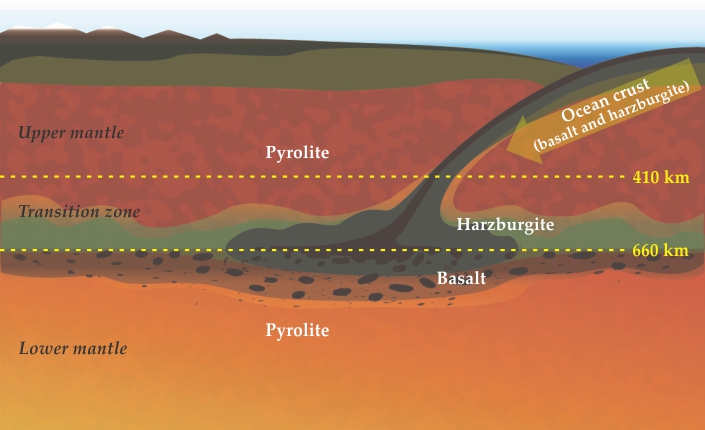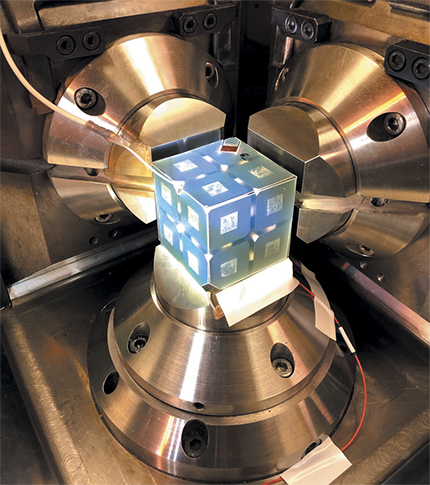Measurements of elusive mineral could explain mantle discontinuity
DOI: 10.1063/PT.3.4159
As Earth’s tectonic plates shift and collide, slabs of cold, dense oceanic crust get pushed down into the mantle. The subduction process carries volatile compounds and water into the mantle along with crustal material that has a different isotopic signature from primitive mantle material. Heat and pressure in Earth’s interior can transform the subducted crust into different minerals and may eventually return it to the surface in the magma that upwells and forms new crust. However, the depth to which crust material descends during that cycling is still a subject of debate among geophysicists and is key to understanding heterogeneities in the mantle structure.
Knowledge of Earth’s interior structure is based on inferences of how seismic waves travel at different depths. The boundary between the upper and lower mantle is marked by a sharp change in density, and therefore of seismic-wave velocities, at a depth of 660 km. Toward the bottom of the upper mantle, at a depth of 410 km, is another density change that marks the beginning of a transition zone. Geophysical simulations suggest that as cold crust material sinks, it undergoes mineral transformations that render it buoyant near the lower boundary of the upper mantle. 1 However, little evidence has been available to support that theory.
Now Steeve Gréaux and colleagues at Ehime University and the Tokyo Institute of Technology in Japan have synthesized a laboratory sample of a calcium–silicon compound that models say should be prevalent in crust rocks that plunge past depths of 560 km. Gréaux and his team have made the first measurements of how sound waves travel through the compound. 2 The measurements match seismic results at the mantle boundary.
Seismic snapshots
Seismic tomography is an important tool for mapping Earth’s interior structure. It uses networks of seismometers that detect surface movements caused by waves both from earthquakes and from controlled explosions generated at the surface. Based on the readings, researchers can calculate the locations of reflection and refraction of the paths the waves took through the interior. Seismic travel-time data are compared to an initial model of Earth’s compositional layering, tectonic structure, and thermal variations. The model is modified to find the best fit between predictions and observations. From the modified model, three-dimensional maps of velocity differences inside Earth are created. Changes in velocity are caused by local density variations in the material and may be correlated with its structure, temperature, or composition.
Seismic tomography reveals several density discontinuities that divide Earth’s mantle into layers. As shown in figure
Figure 1.

Slabs of basaltic oceanic crust and underlying mantle rocks of harzburgite sink into Earth’s mantle during tectonic processes. The boundary between upper and lower mantle is marked by sudden slowing in seismic-wave velocities at depths of around 660 km. New sound-velocity measurements of high-pressure minerals believed to exist in subducted ocean crust suggest that the crust accumulates at the bottom of the mantle transition zone. (Image by Steeve Gréaux.)

In 1962 Alfred Edward Ringwood of Melbourne University developed a model for the mantle’s composition. He proposed that bulk mantle material is a mixture of basalt and peridotite. He called the hypothetical mixture pyrolite. Researchers who have synthesized pyrolite in the lab have found that ultrasonic wave velocities in pyrolite agree with seismic velocities for depths down to 560 km and below 800 km. 3 But between the two depths, pyrolite can’t be responsible for the seismic behavior.
Mineral transformations
A gravitationally stable layer of chemically distinct material could account for the observed seismic discrepancies. Ocean crust consists mainly of basalt and an underlying layer of the igneous rock harzburgite, on top of a peridotite layer. The peridotite may be reabsorbed in the mantle early during subduction, whereas the basalt and harzburgite can travel down to the deep mantle. But ocean crust at mantle temperatures and pressures is transformed into an assemblage of different minerals. The seismic velocities for key minerals thought to occur in that assemblage have not been measured.
One suspected transformation would rearrange calcium and silicon—common elements in the basalt in ocean crust—into a calcium silicate (CaSiO3) phase with a cubic perovskite structure (cubic CaPv) at transition zone depths. A perovskite has the chemical formula ABX3, where A and B represent cations and X is an anion bonded to both. Mineralogy studies suggest that CaSiO3 in its cubic perovskite structure should constitute 30% of any basaltic crust material that has reached the lower mantle. The crust composition offers a possible explanation for the observed slowing of seismic waves just above the boundary at 660 km. 4
Cubic CaPv, though, is not stable under ambient conditions. At room temperature and pressure the mineral is amorphous, and at high pressure and room temperature it takes on a tetragonal structure. Velocity extrapolations based on tetragonal CaPv do not match seismic values in the mantle. The elusive cubic CaPv was first found in 2018 in a South African mine, trapped and encased in a diamond during the diamond’s formation deep in the mantle. 5
Gréaux and colleagues have now met the challenge of measuring the seismic properties of cubic CaPv at conditions akin to those in Earth’s mantle. The researchers compressed a 2-mm-diameter CaSiO3 glass rod at a temperature of 1700 K to a pressure of 23 GPa using a multi-anvil press at the Japan Synchrotron Radiation Research Institute (figure
Figure 2.

Multi-anvil press apparatus at the Japan Synchrotron Radiation Research Institute. Hydraulic rams drive six first-stage steel anvils and distribute force on a cubic arrangement of eight second-stage tungsten carbide anvils. The second-stage anvils compress an octahedral high-pressure cell. (Photo by Steeve Gréaux.)

The researchers measured the time it took for ultrasonic waves to travel through the CaPv in the pressure cell at various temperature and pressure combinations. They used x-ray diffraction to verify that during the experiments the sample had and maintained its cubic structure. By combining the in situ sound-wave travel times and diffraction patterns, the researchers derived sound-wave velocities and elastic moduli for CaPv.
Gréaux’s team found that the shear modulus of cubic CaPv at 23 GPa was 26% lower than estimates calculated from first principles. 6 The unexpectedly low rigidity means that seismic waves travel significantly more slowly in CaPv than previously thought. The velocities match seismic observations at the boundary depth of about 660 km between the upper and lower mantle.
Stagnant slabs
The experiments demonstrate that seismic-wave velocities through subducted oceanic crust are much slower at depths around 660 km than the global average velocities through pyrolite. The results are consistent with oceanic crust stagnating at the top of the lower mantle.
The results do not preclude other possible explanations for slow seismic velocities at the boundary between upper and lower mantle. Hydrated rocks can release water as they are pushed downward. The resulting aqueous fluids can trigger melting in the lower mantle, and melted material could also lead to low seismic velocities. Water-containing minerals encased in diamonds that originated at similar depths provide evidence for dehydration melting. (See the article by Marc Hirschmann and David Kohlstedt, Physics Today, March 2012, page 40
“The deep interior of our planet is still largely unknown, and of particular interest is how it interacts with Earth’s surface over geologic time scales,” says Hauke Marquardt (University of Oxford). Understanding the fate of subducted slabs helps reveal how material is transported deep in the mantle. For example, any crust that accumulates at the bottom of the upper mantle would play a different role in the convective processes that carry molten material back upward than if it reached the core–mantle boundary at 2900 km. (See the article by Eugene Humphreys and Brandon Schmandt, Physics Today, August 2011, page 34
The research combines seismologic observations with experimentally determined properties of minerals to find former oceanic crust in Earth’s mantle. More detailed seismological studies could help map regions of the mantle that have low seismic velocities at a range of depths. Localized maps would reveal differences between shear and compressional wave velocities relative to the surrounding mantle. Additional measurements of sound-wave velocities in single crystals of CaPv and of the polycrystalline samples in Gréaux’s experiments could explain how observed velocities change depending on the direction of travel through the crystal lattice.
References
1. M. D. Ballmer et al., Sci. Adv. 1, e1500815 (2015). https://doi.org/10.1126/sciadv.1500815
2. S. Gréaux et al., Nature 565, 218 (2019). https://doi.org/10.1038/s41586-018-0816-5
3. T. Irifune et al., Nature 451, 814 (2008). https://doi.org/10.1038/nature06551
4. T. Irifune, Nature 370, 131 (1994). https://doi.org/10.1038/370131a0
5. F. Nestola et al., Nature 555, 237 (2018). https://doi.org/10.1038/nature25972
6. L. Stixrude et al., Phys. Rev. B 75, 024108 (2007). https://doi.org/10.1103/PhysRevB.75.024108
